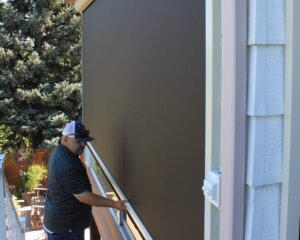If you’re looking for ways to add shade to your patio or backyard, you’ve probably seen shade sails in your search (and in your neighborhood). Shade sails are triangular or rectangular fabric canopies stretched between anchor points to block the sun. They’re popular, lightweight, and available in many colors, making them a quick and attractive outdoor upgrade.
However, in Colorado, the weather can change quickly from sunshine to wind or snow. Shade sails often have trouble lasting through these conditions. If you want a reliable, long-lasting patio shade, retractable awnings may be a better choice.
Here’s a comparison of these two options and why retractable awnings can work better for Denver’s unpredictable climate.
Weather Resistance: Built for Colorado’s Wild Forecasts
Shade sails:
Most shade sails are made from porous, UV-resistant fabric stretched tight between poles or to your home’s structure. While they provide sun protection, they aren’t designed for heavy weather. In Denver and across the Front Range, high winds and unexpected snowstorms can cause sails to sag, tear, or even pull free from their anchors.
Retractable awnings:
Retractable awnings are built for changing conditions. They have strong frames, tensioned arms, and high-quality fabrics that can handle wind and light rain. When bad weather arrives, you can just retract the awning for full protection. Shade sails don’t offer this kind of flexibility.
Maintenance and Longevity
Even when made from quality fabric, shade sails need seasonal care. They collect dirt, sag over time, and can collect water during rain or melting snow. Because they’re exposed year-round, the material can fade and weaken more quickly under the Colorado sun. Most need to be taken down in the winter to avoid damage, which means extra work for homeowners.
Retractable awnings protect themselves when not in use. With the push of a button, the fabric rolls into a cassette that shields it from UV rays, wind, and moisture. Automatic wind sensors take this a step further: if a strong gust puts too much strain on the awning arms, the awning will automatically retract. This protection helps awnings last for many years with little maintenance, often a decade or more before the fabric needs replacing.
Structural Safety and Installation
A shade sail’s effectiveness and longevity also depend a lot on its installation. Each anchor point needs to handle the tension of the stretched fabric and withstand sudden gusts of wind. Over time, that stress can loosen connections or even damage siding, deck posts, or roof fascia boards if not properly reinforced.
Awning installations use mounting brackets designed to distribute weight and tension safely. A qualified installer will ensure your awning is anchored securely to studs or masonry, so you don’t have to worry about shifting loads or damage to your home’s exterior.
Since shade sails are often viewed as a simpler “DIY” way to shade a patio, these structural issues can be common with self-installs. We always recommend using a reputable company for professional installation to avoid damage and safety concerns.
Usability and Convenience
Shade sails can look modern and stylish and can be a wonderful complement to your patio refuge, but it’s important to consider that their shape and angle aren’t adjustable. Once a shade sail is installed, it stays in place. That means your outdoor space gets the same coverage every day, no matter the weather or season. And if you’re worried about inclement weather, taking it down and putting it back up is a manual job. That’s no problem for many homeowners, but if you want more flexibility and less work, an awning may be the choice for you.
Like shade sails, retractable patio awnings can’t be moved to other locations once they’re installed, but the retractable shade does provide more flexibility throughout the day. You can extend your awning for shade and UV protection during sunny afternoons, then retract it to enjoy the stars at night. And extending or retracting awnings is as easy as pushing a button; there’s no need to climb ladders or loosen ropes.
Value and Long-Term Investment
Shade sails can be an affordable patio shading solution, but costs can add up over time with things like replacement, seasonal maintenance, and weather damage. Many homeowners end up replacing sails every few years.
A retractable awning is typically a bigger upfront purchase, but it can hold its value longer. Because you can retract it when not in use, it stays looking new for years. The risks of sagging, fading, and constant upkeep are far less than a sail.
Both options provide shade, boost curb appeal, and enhance your outdoor comfort; which one is best depends on you, your style, and your home!
Finding the Best Patio Shade Option for Colorado Homes
When choosing a patio shade system, it’s also important to think beyond summer. Colorado’s elevation and climate require materials and designs that can handle sun, wind, and snow. Sails work well for summer shade, but may be too labor-intensive in the spring, fall and winter when Colorado weather is the most erratic. Retractable awnings can change at the press of a button, offering the flexibility, protection, and style to make your outdoor space usable in every season.
Bring Comfort and Control to Your Patio with Direct Awnings
At Direct Awnings, we specialize in custom retractable awnings designed for Colorado’s unique conditions. Our products use premium materials, motorized convenience, and professional installation to ensure you achieve the perfect balance of beauty and performance.
Ready to upgrade your patio shade? Contact Direct Awnings today for a free consultation and see how retractable awnings can transform your outdoor space. No stress, just comfortable living year-round.




